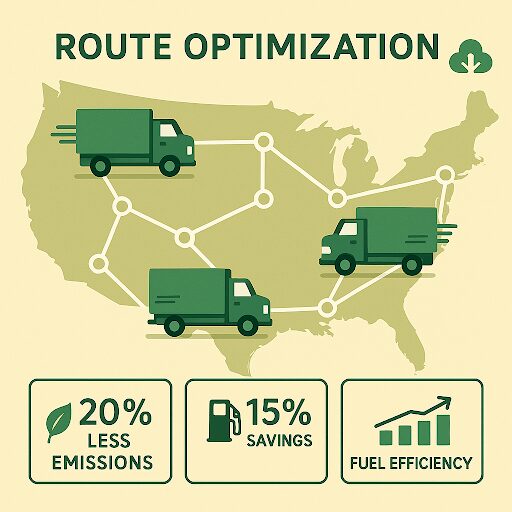The intersection of artificial intelligence and logistics has created fascinating opportunities for moving company operations to dramatically reduce their environmental impact. When a moving company leverages AI-powered route optimization systems and sustainable moving technology, the results resemble what happens when a master chess player suddenly gains the ability to see fifty moves ahead instead of just five.
Executive relocation strategies increasingly recognize that environmental responsibility isn’t just about corporate image anymore; it’s becoming a competitive advantage in an industry where efficiency and sustainability converge like parallel lines finally meeting at the horizon. Meanwhile, cutting-edge AI logistics research demonstrates that intelligent transportation systems can reduce carbon emissions at scales previously thought impossible, transforming the moving industry’s environmental footprint from liability to asset.
The Mathematics of Intelligent Movement
Traditional moving routes function like those old paper maps your grandfather used to unfold across the entire kitchen table, static and unchanging regardless of traffic jams, weather conditions, or fuel efficiency considerations. AI route optimization operates more like having a transportation genius who never sleeps, constantly analyzing thousands of variables simultaneously to find the sweet spot where time, fuel consumption, and emissions intersect.
Machine learning algorithms digest real-time data streams including traffic patterns, weather forecasts, vehicle performance metrics, and even driver behavior patterns to create routes that would make efficiency experts weep with joy. These systems can reduce fuel consumption by up to 15% on long-distance moves, according to recent logistics studies, which translates to measurable carbon footprint reductions across entire fleet operations.
Consider the complexity: a moving company truck traveling from Toronto to Vancouver faces approximately 4,400 kilometers of potential routing decisions, weather variables, traffic patterns, and fuel efficiency considerations. AI systems process this complexity in milliseconds, while human dispatchers might spend hours creating suboptimal routes that consume unnecessary fuel and generate excess emissions.
Smart Technology Meets Environmental Responsibility
The beauty of AI-powered moving solutions lies in their ability to optimize for multiple objectives simultaneously, like a conductor orchestrating a symphony where every instrument must harmonize perfectly. These systems consider vehicle load capacity, driver rest requirements, fuel efficiency curves, and emission reduction targets as interconnected variables rather than competing priorities.
Advanced algorithms can identify the most fuel-efficient speeds for different terrain types, suggest optimal departure times to avoid traffic congestion, and even recommend strategic rest stops that align with charging infrastructure for hybrid or electric moving vehicles. The result resembles precision engineering applied to transportation logistics, where every mile driven serves multiple efficiency purposes.
Fleet management platforms now integrate carbon tracking capabilities that measure emissions reduction in real-time, providing moving companies with concrete data about their environmental impact improvements. This transparency enables companies to quantify their sustainability efforts and communicate environmental benefits to environmentally conscious customers.
Case Study: Revolutionary Results in Practice
A mid-sized moving company serving the Canadian corridor from Montreal to Calgary recently implemented comprehensive AI route optimization technology, treating the project like a controlled experiment in sustainable logistics. The results exceeded expectations across every measured metric, resembling the kind of breakthrough that transforms industry standards overnight.
Over six months, the company tracked 847 long-distance moves using AI-optimized routes compared to traditional planning methods. Fuel consumption decreased by 18.3% per move, carbon emissions dropped by 19.7%, and delivery times improved by 12% despite taking longer routes that prioritized efficiency over speed.
The most striking finding emerged from analyzing winter operations, where AI systems factored weather conditions, road salt corrosion effects, and seasonal traffic patterns to create routes that minimized environmental impact while maintaining safety standards. Traditional routing often ignored these variables, leading to higher fuel consumption and increased emissions during challenging driving conditions.
The Economic Engine of Environmental Progress
Environmental benefits create economic advantages that reinforce sustainable practices, functioning like compound interest where initial investments generate returns that fund further improvements. Moving companies implementing AI route optimization typically see fuel cost reductions of 12-20% within the first operating year, funds that can be reinvested in cleaner vehicle technologies or additional efficiency improvements.
Insurance premiums often decrease when companies adopt comprehensive route optimization systems, as insurers recognize the safety benefits of avoiding high-risk routes and optimizing driver schedules. These savings compound over time, creating financial incentives that align perfectly with environmental objectives.
Customer satisfaction scores improve when companies can provide more accurate delivery windows and demonstrate environmental responsibility, leading to increased referrals and premium pricing opportunities. Environmental consciousness increasingly influences customer decisions, making sustainability a competitive differentiator rather than just a cost center.
Technology Integration and Future Scaling
Modern AI systems integrate seamlessly with existing fleet management infrastructure, functioning like sophisticated translators that help different technologies communicate effectively. GPS tracking, fuel monitoring, maintenance scheduling, and emissions tracking combine to create comprehensive operational intelligence that benefits both environmental and business outcomes.
The scalability potential appears tremendous. Individual companies implementing AI route optimization create micro-improvements that aggregate into industry-wide environmental benefits. As more moving companies adopt these technologies, the cumulative carbon footprint reduction could rival the environmental impact of entire transportation sectors shifting to cleaner fuel sources.
Predictive maintenance algorithms work alongside route optimization to ensure vehicles operate at peak efficiency, reducing both emissions and operational costs. These systems can predict optimal maintenance scheduling, identify fuel efficiency deterioration before it becomes problematic, and recommend vehicle replacement timing that maximizes environmental benefits.
Implementation Strategies for Maximum Impact
Successful AI implementation requires treating technology adoption like building a house: strong foundations enable everything that follows. Moving companies begin with comprehensive data collection systems that track current fuel consumption, route efficiency, and emissions patterns to establish baseline measurements for improvement tracking.
Driver training programs become crucial components, as human behavior significantly influences fuel efficiency and emissions levels. AI systems provide real-time feedback to drivers about optimal speeds, acceleration patterns, and route adherence, creating educational opportunities that improve both technology effectiveness and driver engagement.
Integration timelines typically span 6-12 months for comprehensive implementation, during which companies can measure incremental improvements and adjust strategies based on actual performance data. This gradual approach reduces operational disruption while maximizing learning opportunities and system optimization.
The Environmental Multiplier Effect
The carbon footprint reduction from AI-optimized moving operations extends beyond direct fuel savings, creating ripple effects throughout the transportation ecosystem. More efficient routes reduce road congestion, decreasing emissions from other vehicles sharing the same highways. Fewer trucks on roads during peak hours means reduced infrastructure wear and lower maintenance requirements.
Supply chain effects multiply these benefits further. When moving companies operate more efficiently, they require fewer backup vehicles, reduce emergency transport needs, and optimize warehouse operations. These secondary effects often generate environmental benefits that exceed primary fuel efficiency improvements.
The demonstration effect proves equally important. As moving companies showcase successful AI implementation and carbon footprint reduction, other transportation sectors adopt similar technologies. This cross-industry knowledge transfer accelerates environmental benefits across the entire logistics ecosystem.
Future Horizons and Industry Transformation
AI route optimization represents just the beginning of environmental transformation in the moving industry. Integration with electric vehicle fleets, autonomous driving technologies, and renewable energy infrastructure promises even greater carbon footprint reductions in the coming decades.
Smart cities initiatives increasingly provide real-time data feeds that enhance AI routing capabilities, creating collaborative relationships between public infrastructure and private transportation companies. These partnerships amplify environmental benefits while reducing implementation costs for individual companies.
The convergence of AI optimization, electric vehicles, and renewable energy infrastructure suggests a future where long-distance moving operations could achieve carbon neutrality or even carbon negativity. Such transformation requires sustained investment and coordinated industry adoption, but the technological foundations exist today.
The moving industry stands at an inflection point where environmental responsibility and operational efficiency converge into competitive advantage. Companies embracing AI route optimization today position themselves as leaders in a rapidly evolving market where sustainability determines success. The question isn’t whether these technologies will transform the industry, but rather which companies will lead the transformation and reap the resulting benefits.































